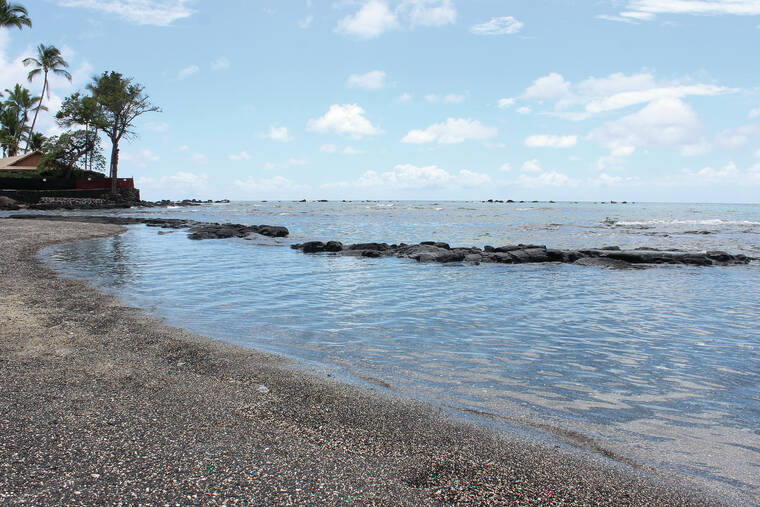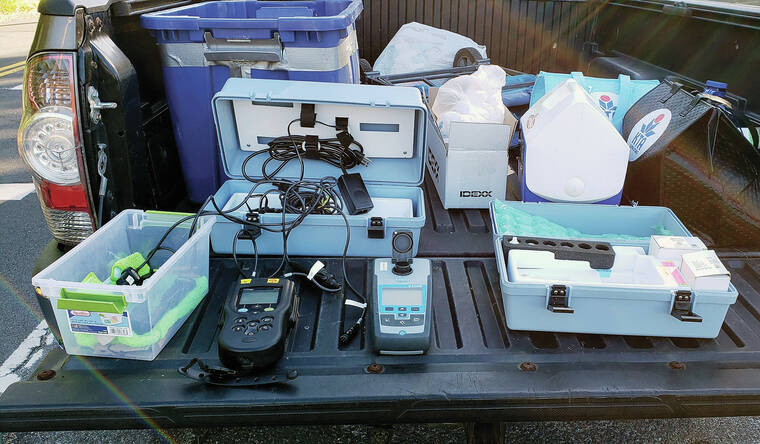A new dataset, made public this month by Hawaii Wai Ola, gives community members access to high quality, open-source water quality testing data dating back to June 2020.
Volunteers and members of Hawaii Wai Ola, a local community hui founded by the Coral Reef Alliance to improve water quality, have taken monthly water quality samples at popular sites around Hawaii Island, including Kahalu’u Bay, Richardson Beach Park, Carlsmith Beach Park, Puhi Bay Beach, Reeds Bay Beach and Moku Ola Beach. The new dataset includes metrics from these locations on pH, salinity, temperature, turbidity, nutrients and enterococcus levels, commonly used indicators of sewage pollution in nearshore ocean environments the alliance announced.
“The fact that we have this data set is incredibly exciting,” said Erica Perez, senior program manager at the Coral Reef Alliance and founding member of Hawaii Wai Ola. “These are sites that aren’t tested by the Department of Health, so this is the first time this information is being made available to people.”
In West Hawaii, five sites along Kahaluu, Puako, Waialea Bay and Hapuna Beach are regularly tested.
While DOH regularly tracks water quality throughout the state, its resources are limited and as a result, there are critical knowledge gaps in the information collected. Hawaii Wai Ola uses the same methods as DOH to make sure its data can be imported into the state system for analysis.
“DOH can’t take action to address poor water quality if they don’t know when the water quality is poor,” said Perez. “The purpose of our program at Hawaii Wai Ola is to empower local communities to work alongside DOH and help expand their understanding of ocean water quality and overcome their resource barriers.”
For example, this new data shows several beaches have experienced unhealthy enterococcus levels over the last year and a half. Richardson Beach Park measured 1119 CFU per 100 mL in August 2020 — that’s nearly nine times higher than the levels considered healthy by the U.S. Environmental Protection Agency. The state Department of Health issues an alert for any area experiencing levels of 104 CFU per 100 mL or above for a single sample.
But Perez warns that it’s important not to jump to conclusions when noticing one-off data points like this, and instead to focus on the fact that the community near Richardson Beach Park can now work with DOH to identify if there’s a bigger problem and find a resolution.
“These are one-time sampling events that happen once a month, so they don’t necessarily give the full story,” said Perez. “Enterococcus levels can change rapidly based on tides, currents, weather events, etc. It could rain and cesspools could leach into the groundwater and into the shoreline, and then it could be gone the next day. So these levels aren’t always an indicator of an ongoing problem.”
Perez said other parameters will be included as the testing program grows.
“All of the parameters that we’d like to include as the program grows are ones that are already established through EPA guidelines. For example, there are additional indicators for bacteria that we could analyze, there are additional nutrients that we can look at, and there are different ways that we can measure turbidity to also assess sediment pollution,” she said.
The hui is working with the community to ensure they know about this new resource and they have shared the dataset with DOH so they can conduct a more thorough analysis. This new knowledge will be included in DOH’s bi-annual ocean beach health report the state uses to identify areas of concern.
The whole program and the fact that this data now exists highlights the power of citizen science networks, said Manuel Mejia, the Hawaii regional program director for the Coral Reef Alliance. Hawaii Wai Ola and the Coral Reef Alliance are working to train community volunteers to collect water quality samples following DOH protocols. Volunteers will then bring the samples to a water quality lab in Kona for analysis.
“We use a private microbiologist to do the bacterial analysis, and we work directly with the Natural Energy Lab of Hawaii Authority to do the nutrient analysis. We collect in-situ parameters like temperature, salinity, turbidity, etc. ourselves when we gather the water samples,” said Perez.
“We can’t manage what we can’t measure,” said Mejia. “But we can give communities the tools they need to start measuring, and to advocate for an improvement in water quality which is so desperately needed across our islands. Allowing local communities to have more ownership over their resources and to have a say over how they’re utilized is invaluable.”
Perez said as Hawaii Wai Ola garners more funding and volunteers, more sites will be included in testing with a strategic goal of testing 100 locations.
“One of the highest determinants of where we sample is community engagement. The reason we’re sampling at the places we are is because there was a really invested community that was interested in picking up sampling immediately,” she said.
Hawaii Wai Ola is actively looking for volunteers. If a community member is interested in volunteering to collect water quality samples, it would take anywhere from 2 to 5 hours per sampling event, with sampling events once per month.
The new dataset can be viewed online at hawaiiwaiola.com/data.


